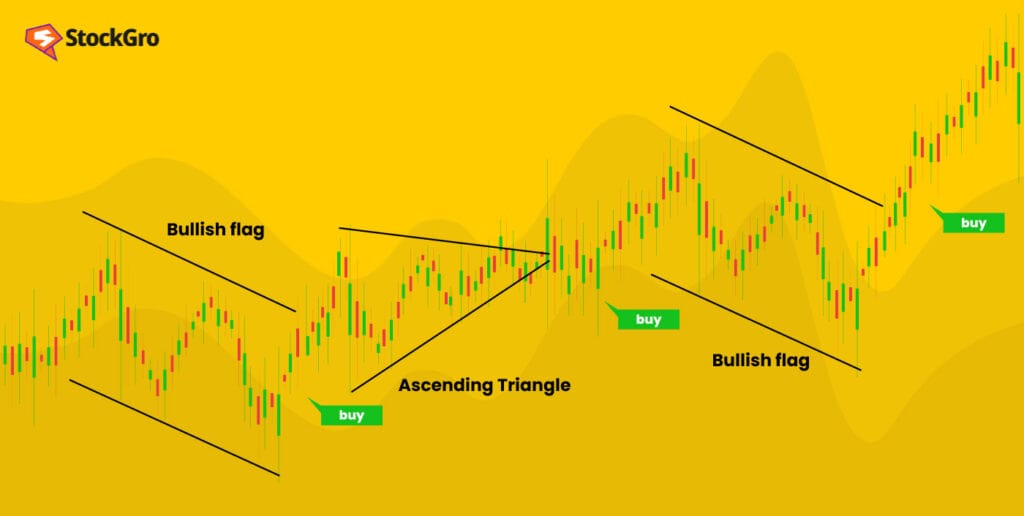
Welcome to the world of candlestick chart patterns! These beautiful visual representations hold the secrets to understanding the stock market’s heartbeat. If you’ve ever felt overwhelmed by stock market charts, don’t worry.
This guide is here to introduce you to the intriguing world of candlestick patterns in a simple and engaging manner.
What is a candlestick pattern?
Imagine the stock market as a story. Each day tells a chapter, and every chapter has its own symbol – a candlestick. A candlestick pattern tells the tale of buyers and sellers in the market, showcasing their sentiments, fears, and expectations.
The basics of how to read a candlestick chart
Here’s a breakdown of all the elements you need to know when reading a candlestick on a chart:
Body: The central rectangular area of the candlestick represents the price difference between the open and close for a specific time period (e.g., a day, week, month).
- Filled body: A filled body indicates whether the closing price was higher (typically green or white) or lower (typically red or black) than the opening price.
- Hollow body: A hollow body (sometimes called an “empty” or “doji” candlestick) signifies the closing and opening prices were very close, or even identical.
Wicks (Shadows): The thin lines extending above and below the body represent the highest and lowest prices reached during the trading period.
- Upper wick (Shadow): This line extends from the top of the body and represents the highest price traded during the period.
- Lower wick (Shadow): This line extends from the bottom of the body and represents the lowest price traded during the period.
Interpreting these signals
- Large filled body: A large filled body suggests strong buying (green/white) or selling (red/black) pressure, depending on the fill colour.
- Small filled body: A small filled body indicates a narrow price range and indecision in the market.
- Long upper wick: A long upper wick suggests buyers attempted to push the price higher but were ultimately unsuccessful (potentially a sign of selling pressure).
- Long lower wick: A long lower wick suggests sellers attempted to push the price lower but were ultimately unsuccessful (potentially a sign of buying pressure).
Why use candlestick patterns?
- Visual appeal: Unlike other chart types, candlestick chart patterns are colourful and easy to interpret
- Immediate insights: Just by glancing at a candlestick, you can quickly gauge who’s winning – the buyers or the sellers
- Predictive power: Some patterns can hint at future price movements, giving traders an edge
Understanding the basics of primary patterns
- The bullish engulfing: A sign of potential upward movement
- The bearish engulfing: Indicates potential downward trends
- The doji: Represents indecision in the market
- The hammer and hanging man: These patterns tell about trend reversals
Types of candlestick patterns
As you get comfortable with the basics, you’ll discover that there are numerous types of candlestick patterns. Some of the prominent ones include:
- Spinning tops have long upper and lower shadows, signifying indecision between buyers and sellers.
- Morning and evening stars are three-candle patterns, indicating a reversal in the current trend.
- Three black crows and three white soldiers: As the names suggest, they indicate strong downtrends and uptrends, respectively.
35 powerful candlestick patterns
While it’s not feasible to list all 35 here, understanding that there are 35 powerful candlestick patterns can empower traders with multiple tools for analysis. Some of the notable ones include:
- Shooting star
- Piercing line
- Dark cloud cover
- Tweezers top and bottom
Trading candlestick patterns
Understanding candlestick patterns is an art. Here are some steps to help beginners:
- Study the basics: Before diving into trading, familiarise yourself with basic patterns.
- Practice with a demo account: Before investing real money, try out your knowledge on a demo account.
- Look for confirmations: One pattern alone might not give a full story. Look for other indicators to confirm your analysis.
- Stay updated: The stock market is dynamic. Always keep learning and stay updated with new patterns and strategies.
Stock market candle patterns and their significance
The stock market often displays recurring patterns. RecognisingRecognizing these can be a game-changer. For instance:
- The cup and handle: Indicates a bullish continuation pattern and can be a sign of a breakout.
- The falling and rising wedge: These can be used to predict reversals or continuations based on their placement in the trend.
- The head and shoulders: A pattern that signals a reversal in the trend.
Choosing the best candlestick patterns for trading
Every trader has their favouritefavorite patterns. What’s essential is to understand their significance, reliability, and context. Some universally accepted best candlestick patterns include:
- Pin Bar
- Inside Bar
- Engulfing Pattern
- Two Bar Reversal
Tips for beginners about candlestick patterns
1. Start with core patterns
While there are over 35 powerful candlestick patterns to learn, begin with the primary ones. Understand their structure, meaning, and implications. Once you’re confident, delve deeper into complex patterns.
2. Combine with other technical tools
Relying solely on candlestick patterns might not always be fruitful. Integrate them with other technical analysis tools like moving averages, RSI (Relative Strength Index), and Bollinger Bands. This provides a broader view of the market and enhances decision-making.
3. Practice makes perfect
Reading and understanding candlestick patterns is one thing, but real-world application is another. Utilise platforms offering virtual trading to apply your knowledge without any financial risk. This practical experience is invaluable.
4. Stay alert to market news
While candlestick patterns give a lot of insight, they don’t operate in isolation. World events, company news, and economic indicators can all influence stock prices. Being informed helps in making more accurate predictions.
5. Join a trading community
Engage with other traders online or offline. Sharing experiences and strategies can provide fresh perspectives. Plus, discussing what is a candlestick pattern and its implications with others can solidify your understanding.
6. Continue education
The world of trading is vast and ever-evolving. New strategies, patterns, and tools frequently emerge. Enrol in courses, attend webinars, and read books to keep up with the latest in trading candlestick patterns.
Practise reading candlestick patterns
Candlestick patterns are the most widely used chart type in the trading community. This is because of the sheer amount of data a candle can convey at one look.
Although anyone can identify what the chart says after spending one hour on a blogpost or course video, it is a different skill altogether to read the candlestick patterns.
To identify trends and similarities between candles and different charts takes a lot of experience and time. However, here are a few ways you can start:
- Start reading up: There is absolutely no dearth of reading and viewing materials when it comes to trading candlestick charts. You can find free and paid courses specifically designed to teach how to really understand candlestick patterns. These often include predictions, elements, and quizzes to test your knowledge. If you want to really get into it, reading books by former traders and hedge fund managers can also be a great idea.
- Paper trading: This is one of the most popular ways newbies to the trading world learn to read charts – paper trading. In this exercise, you simulate a trade in the real stock market but don’t actually trade any real money.
The classic way is to study the charts earnestly just like you would in real life. When you identify a potential trade you want to take, write down the details of your entry and exit – the price, quantity, stop-losses, etc. and see how it goes. Remember to treat it as seriously as the real thing to identify your mistakes and learn to calm your nerves.
There are also paper trading software available online that can simulate real-world conditions using virtual currency. - Analyse price movements: Load historical charts of various assets (stocks, forex, etc.) and identify past instances of different candlestick patterns. Analyse how the price action unfolded after the appearance of each pattern. This will help you understand the implications of each pattern.
It is always a good idea to start with securities that have high trading liquidity. By doing this, you will be gauging reactions based on genuine market sentiment, not abnormalities caused due to low trading activity.
Over time, as you learn how patterns work and start making hypothetical profits off of your paper trades, you can move on to real money.
Avoid common mistakes
While candlestick patterns are powerful, it’s easy to misinterpret or misuse them. Here are some pitfalls to avoid:
- Overtrading: Just because you spot a pattern doesn’t mean you should trade. Look for high-probability setups and be patient.
- Ignoring the bigger picture: Candlestick patterns are crucial, but always zoom out and consider the overall trend.
- Falling for false signals: Not every pattern you spot will result in a predictable outcome. Always use stop-loss strategies to protect your investments.
Overview of primary candlestick patterns
| Pattern name | Visual description | Significance in trading |
| Bullish Engulfing | A small bearish (red) candle followed by a larger bullish (green) candle that completely engulfs the previous one | Indicates potential upward price movement |
| Bearish Engulfing | A small bullish (green) candle followed by a larger bearish (red) candle that completely engulfs the previous one | Indicates potential downward price movement |
| Doji | A candle with a very thin body, showcasing almost equal open and close prices | Represents market indecision |
| Hammer | A candle with a small body at the top and a long lower shadow, with little or no upper shadow | Suggests a potential bullish reversal during a downtrend |
| Hanging Man | A candle with a small body at the top and a long lower shadow, with little or no upper shadow | Suggests a potential bearish reversal during an uptrend |
This table offers a condensed view of the primary patterns, helping beginners quickly grasp these essential patterns and their significance in the trading world.
Final words
As we wrap up our beginner’s journey into the world of candlestick chart patterns, remember that these patterns are tools. Just as a painter needs more than one brush, a trader should be equipped with a wide array of patterns and knowledge.
The key is consistent learning, practice, and experience. With time, you’ll be able to read the stock market’s story just by glancing at a candlestick chart. Happy trading!

